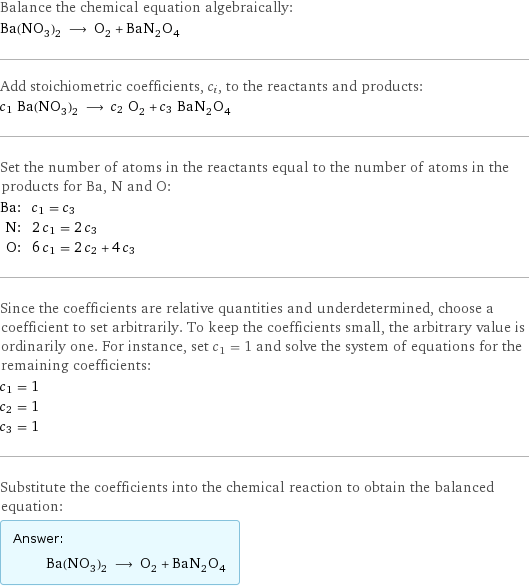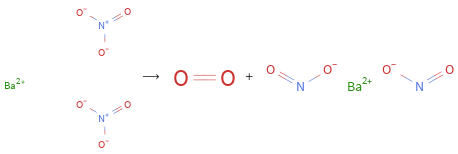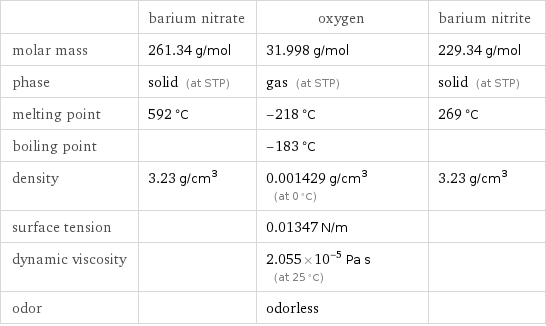Input interpretation

Ba(NO_3)_2 barium nitrate ⟶ O_2 oxygen + BaN_2O_4 barium nitrite
Balanced equation

Balance the chemical equation algebraically: Ba(NO_3)_2 ⟶ O_2 + BaN_2O_4 Add stoichiometric coefficients, c_i, to the reactants and products: c_1 Ba(NO_3)_2 ⟶ c_2 O_2 + c_3 BaN_2O_4 Set the number of atoms in the reactants equal to the number of atoms in the products for Ba, N and O: Ba: | c_1 = c_3 N: | 2 c_1 = 2 c_3 O: | 6 c_1 = 2 c_2 + 4 c_3 Since the coefficients are relative quantities and underdetermined, choose a coefficient to set arbitrarily. To keep the coefficients small, the arbitrary value is ordinarily one. For instance, set c_1 = 1 and solve the system of equations for the remaining coefficients: c_1 = 1 c_2 = 1 c_3 = 1 Substitute the coefficients into the chemical reaction to obtain the balanced equation: Answer: | | Ba(NO_3)_2 ⟶ O_2 + BaN_2O_4
Structures

⟶ +
Names

barium nitrate ⟶ oxygen + barium nitrite
Reaction thermodynamics
Enthalpy

| barium nitrate | oxygen | barium nitrite molecular enthalpy | -988 kJ/mol | 0 kJ/mol | -768.2 kJ/mol total enthalpy | -988 kJ/mol | 0 kJ/mol | -768.2 kJ/mol | H_initial = -988 kJ/mol | H_final = -768.2 kJ/mol | ΔH_rxn^0 | -768.2 kJ/mol - -988 kJ/mol = 219.8 kJ/mol (endothermic) | |
Equilibrium constant
![Construct the equilibrium constant, K, expression for: Ba(NO_3)_2 ⟶ O_2 + BaN_2O_4 Plan: • Balance the chemical equation. • Determine the stoichiometric numbers. • Assemble the activity expression for each chemical species. • Use the activity expressions to build the equilibrium constant expression. Write the balanced chemical equation: Ba(NO_3)_2 ⟶ O_2 + BaN_2O_4 Assign stoichiometric numbers, ν_i, using the stoichiometric coefficients, c_i, from the balanced chemical equation in the following manner: ν_i = -c_i for reactants and ν_i = c_i for products: chemical species | c_i | ν_i Ba(NO_3)_2 | 1 | -1 O_2 | 1 | 1 BaN_2O_4 | 1 | 1 Assemble the activity expressions accounting for the state of matter and ν_i: chemical species | c_i | ν_i | activity expression Ba(NO_3)_2 | 1 | -1 | ([Ba(NO3)2])^(-1) O_2 | 1 | 1 | [O2] BaN_2O_4 | 1 | 1 | [BaN2O4] The equilibrium constant symbol in the concentration basis is: K_c Mulitply the activity expressions to arrive at the K_c expression: Answer: | | K_c = ([Ba(NO3)2])^(-1) [O2] [BaN2O4] = ([O2] [BaN2O4])/([Ba(NO3)2])](../image_source/c05091e869f8801402ec87ece8b10626.png)
Construct the equilibrium constant, K, expression for: Ba(NO_3)_2 ⟶ O_2 + BaN_2O_4 Plan: • Balance the chemical equation. • Determine the stoichiometric numbers. • Assemble the activity expression for each chemical species. • Use the activity expressions to build the equilibrium constant expression. Write the balanced chemical equation: Ba(NO_3)_2 ⟶ O_2 + BaN_2O_4 Assign stoichiometric numbers, ν_i, using the stoichiometric coefficients, c_i, from the balanced chemical equation in the following manner: ν_i = -c_i for reactants and ν_i = c_i for products: chemical species | c_i | ν_i Ba(NO_3)_2 | 1 | -1 O_2 | 1 | 1 BaN_2O_4 | 1 | 1 Assemble the activity expressions accounting for the state of matter and ν_i: chemical species | c_i | ν_i | activity expression Ba(NO_3)_2 | 1 | -1 | ([Ba(NO3)2])^(-1) O_2 | 1 | 1 | [O2] BaN_2O_4 | 1 | 1 | [BaN2O4] The equilibrium constant symbol in the concentration basis is: K_c Mulitply the activity expressions to arrive at the K_c expression: Answer: | | K_c = ([Ba(NO3)2])^(-1) [O2] [BaN2O4] = ([O2] [BaN2O4])/([Ba(NO3)2])
Rate of reaction
![Construct the rate of reaction expression for: Ba(NO_3)_2 ⟶ O_2 + BaN_2O_4 Plan: • Balance the chemical equation. • Determine the stoichiometric numbers. • Assemble the rate term for each chemical species. • Write the rate of reaction expression. Write the balanced chemical equation: Ba(NO_3)_2 ⟶ O_2 + BaN_2O_4 Assign stoichiometric numbers, ν_i, using the stoichiometric coefficients, c_i, from the balanced chemical equation in the following manner: ν_i = -c_i for reactants and ν_i = c_i for products: chemical species | c_i | ν_i Ba(NO_3)_2 | 1 | -1 O_2 | 1 | 1 BaN_2O_4 | 1 | 1 The rate term for each chemical species, B_i, is 1/ν_i(Δ[B_i])/(Δt) where [B_i] is the amount concentration and t is time: chemical species | c_i | ν_i | rate term Ba(NO_3)_2 | 1 | -1 | -(Δ[Ba(NO3)2])/(Δt) O_2 | 1 | 1 | (Δ[O2])/(Δt) BaN_2O_4 | 1 | 1 | (Δ[BaN2O4])/(Δt) (for infinitesimal rate of change, replace Δ with d) Set the rate terms equal to each other to arrive at the rate expression: Answer: | | rate = -(Δ[Ba(NO3)2])/(Δt) = (Δ[O2])/(Δt) = (Δ[BaN2O4])/(Δt) (assuming constant volume and no accumulation of intermediates or side products)](../image_source/03698867a1216186be6f7f4bdba4962f.png)
Construct the rate of reaction expression for: Ba(NO_3)_2 ⟶ O_2 + BaN_2O_4 Plan: • Balance the chemical equation. • Determine the stoichiometric numbers. • Assemble the rate term for each chemical species. • Write the rate of reaction expression. Write the balanced chemical equation: Ba(NO_3)_2 ⟶ O_2 + BaN_2O_4 Assign stoichiometric numbers, ν_i, using the stoichiometric coefficients, c_i, from the balanced chemical equation in the following manner: ν_i = -c_i for reactants and ν_i = c_i for products: chemical species | c_i | ν_i Ba(NO_3)_2 | 1 | -1 O_2 | 1 | 1 BaN_2O_4 | 1 | 1 The rate term for each chemical species, B_i, is 1/ν_i(Δ[B_i])/(Δt) where [B_i] is the amount concentration and t is time: chemical species | c_i | ν_i | rate term Ba(NO_3)_2 | 1 | -1 | -(Δ[Ba(NO3)2])/(Δt) O_2 | 1 | 1 | (Δ[O2])/(Δt) BaN_2O_4 | 1 | 1 | (Δ[BaN2O4])/(Δt) (for infinitesimal rate of change, replace Δ with d) Set the rate terms equal to each other to arrive at the rate expression: Answer: | | rate = -(Δ[Ba(NO3)2])/(Δt) = (Δ[O2])/(Δt) = (Δ[BaN2O4])/(Δt) (assuming constant volume and no accumulation of intermediates or side products)
Chemical names and formulas

| barium nitrate | oxygen | barium nitrite formula | Ba(NO_3)_2 | O_2 | BaN_2O_4 Hill formula | BaN_2O_6 | O_2 | BaN_2O_4 name | barium nitrate | oxygen | barium nitrite IUPAC name | barium(+2) cation dinitrate | molecular oxygen | barium(+2) cation dinitrite
Substance properties

| barium nitrate | oxygen | barium nitrite molar mass | 261.34 g/mol | 31.998 g/mol | 229.34 g/mol phase | solid (at STP) | gas (at STP) | solid (at STP) melting point | 592 °C | -218 °C | 269 °C boiling point | | -183 °C | density | 3.23 g/cm^3 | 0.001429 g/cm^3 (at 0 °C) | 3.23 g/cm^3 surface tension | | 0.01347 N/m | dynamic viscosity | | 2.055×10^-5 Pa s (at 25 °C) | odor | | odorless |
Units
